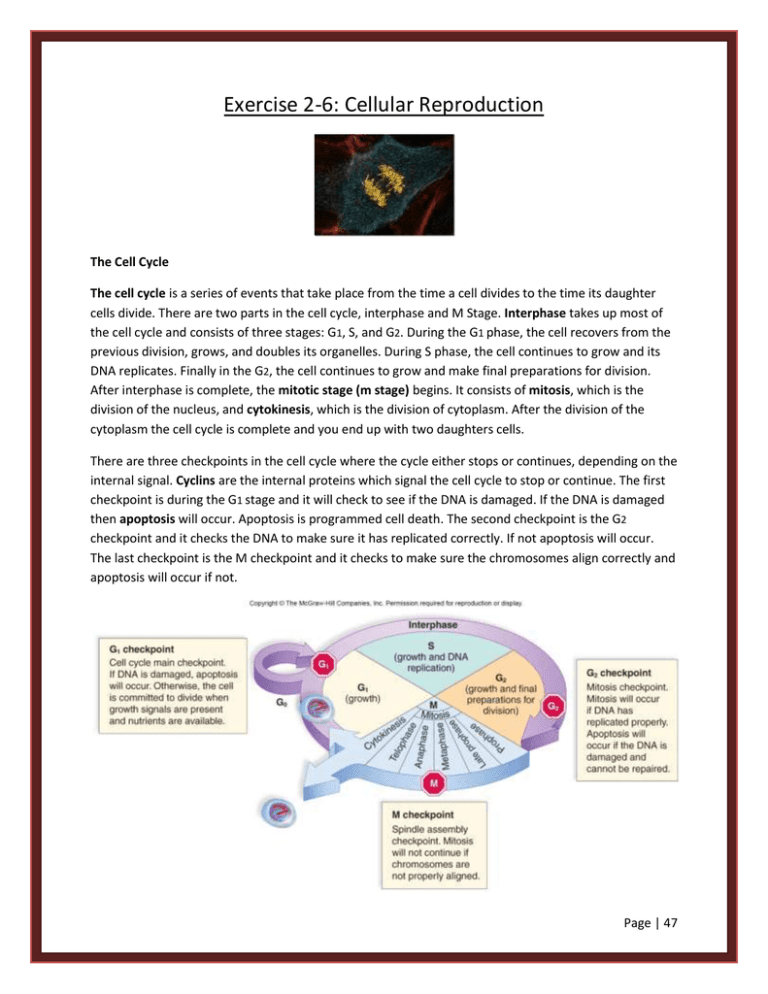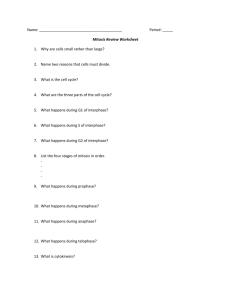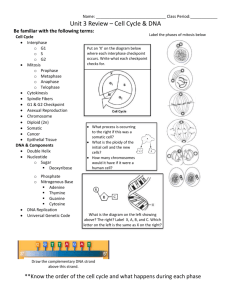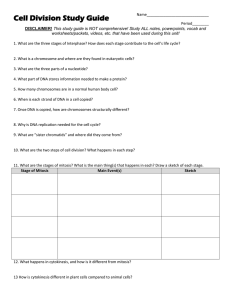Mitosis - Chapter 9 - WSCC Biology Tutoring
advertisement

Exercise 2-6: Cellular Reproduction The Cell Cycle The cell cycle is a series of events that take place from the time a cell divides to the time its daughter cells divide. There are two parts in the cell cycle, interphase and M Stage. Interphase takes up most of the cell cycle and consists of three stages: G1, S, and G2. During the G1 phase, the cell recovers from the previous division, grows, and doubles its organelles. During S phase, the cell continues to grow and its DNA replicates. Finally in the G2, the cell continues to grow and make final preparations for division. After interphase is complete, the mitotic stage (m stage) begins. It consists of mitosis, which is the division of the nucleus, and cytokinesis, which is the division of cytoplasm. After the division of the cytoplasm the cell cycle is complete and you end up with two daughters cells. There are three checkpoints in the cell cycle where the cycle either stops or continues, depending on the internal signal. Cyclins are the internal proteins which signal the cell cycle to stop or continue. The first checkpoint is during the G1 stage and it will check to see if the DNA is damaged. If the DNA is damaged then apoptosis will occur. Apoptosis is programmed cell death. The second checkpoint is the G2 checkpoint and it checks the DNA to make sure it has replicated correctly. If not apoptosis will occur. The last checkpoint is the M checkpoint and it checks to make sure the chromosomes align correctly and apoptosis will occur if not. Page | 47 Mitosis and Cytokinesis Now that we know about the first part of the cell cycle, interphase, the second part is the M Stage. The M Stage includes the processes known as mitosis and cytokinesis. Mitosis is the nuclear division and cytokinesis is the division of the cytoplasm. When a eukaryotic cell is not undergoing division, the DNA is known as Chromatin. It looks like tangled threads. The DNA coils around proteins called histones and the chromatin condenses and coils during mitosis and the individual chromosomes become visible as shown below. Every species contains a specific number of chromosomes. The full set of chromosomes include two of each kind and are known as diploid (2n). Half of the diploid number is known as haploid (n). When the chromatin is condensed and coiled, it then replicates to form the “X” shape we know as a chromosome. Each of the arms are known as sister chromatids and are held together by a centromere. The centrosome is the main microtubule organizing center in the animal cell. It divides before mitosis begins. It contains a pair of barrel shaped organelles called centrioles which initiate and organize the mitotic spindle which contain many fibers, each composed of a bundle of microtubules. Page | 48 There are five main phases of mitosis: prophase, prometaphase, metaphase, anaphase, and telaphase. During prophase the chromatin is condensed and replicated as the nucleolus disappears. The nuclear envelope disintegrates and the mitotic spindle begins to form. During prometaphase the kinetochores develop on the centromere; they attach the sister chromatids to the spindle fibers. During metaphase the chromosomes align in the middle of the cell. Anaphase: the sister chromatids split and each half is pulled to opposite poles. Telophase is the last phase in mitosis and during it the spindle disappears, new nuclear envelope forms, the chromosomes become diffuse chromatin again, and the nucleolus appears in each new nucleus. Cytokinesis accompanies mitosis in most cells. It begins in anaphase and continues through telophase and ends in interphase. If cytokinesis does not occur then the result will be multinucleated cells. In animal cells, cytokinesis starts with a cleavage furrow and contractile rings form between the two daughter cells. In plant cells, instead of cytokinesis, a cell plate forms to produce the cell wall. Page | 49 Prokaryotic Cell Division In prokaryotes, cell division is known as binary fission. They have a single chromosome in an area called a nucleoid. The DNA replicates and the cell wall and membrane begin to grow inward. Cancer Cancer is a growth disorder that results from mutations of genes regulating the cell cycle. Caricinogenesis is the development of cancer, which tends to be gradual. The characteristics of cancer cells are they lack differentiation. They have abnormal nuclei. They do not undergo apoptosis. They form tumors. They undergo metastasis and angiogenesis. Page | 50 Directions: put the following pictures in the correct order in which mitosis occurs. Also label each picture with the correct phase name. 1 2 3 4 5 1. 2. 3. 4. 5. Order: Page | 51






